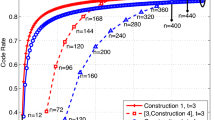Abstract
Let \(M = (s_1, s_2, \ldots , s_n) \) be a sequence of distinct symbols and \(\sigma \) a permutation of \(\{1,2, \ldots , n\}\). Denote by \(\sigma (M)\) the permuted sequence \((s_{\sigma (1)}, s_{\sigma (2)}, \ldots , s_{\sigma (n)})\). For a given positive integer d, we will say that \(\sigma \) is d-resilient if no matter how d entries of M are removed from M to form \(M'\) and d entries of \(\sigma (M)\) are removed from \(\sigma (M)\) to form \(\sigma (M)'\) (with no symbol being removed from both sequences), it is always possible to reconstruct the original sequence M from \(M'\) and \(\sigma (M)'\). Necessary and sufficient conditions for a permutation to be d-resilient are established in terms of whether certain auxiliary graphs are acyclic. We show that for d-resilient permutations for [n] to exist, n must have size at least exponential in d, and we give an algorithm to construct such permutations in this case. We show that for each d and all sufficiently large n, the fraction of all permutations on n elements which are d-resilient is bounded away from 0.



Similar content being viewed by others
Notes
This process is similar to what is done to construct random graphs with prescribed degrees; namely, we have a matching (the connections joining indices in the top and bottom lines), and then we group a cluster of endpoints together to form a vertex. Here our clusters are defined by the contiguous blocks.
References
N. Alon, S. Hoory and N. Linial, The Moore bound for irregular graphs, Graphs and Combin. 18 (2002), 53–57.
P. Erdős and H. Sachs, Reguläre Graphen gegebener Taillenweite mit minimaler Knotenzahl, Wiss. Z. Matin-Luther-Univ. Halle-Wittenberg Math.-Natur. Reihe 12 (1963), 251–257.
J. H. Kim and N. Wormald, Random matchings which induce Hamilton cycles and Hamiltonian decompositions of random regular graphs, J. Combin. Theory Ser. B 81 (2001), 20–44.
Acknowledgements
Utkrisht Rajkumar thanks Young-Han Kim for support and guidance. Noga Alon and Ron Graham thank the Simons Institute for the Theory of Computing at UC Berkeley, where part of this work was done. The authors thank the referees for feedback on an earlier version of this paper.
Author information
Authors and Affiliations
Corresponding author
Additional information
(Alon) Research supported in part by a BSF grant, an ISF grant and a GIF grant. (Butler) Partially supported by a grant from the Simons Foundation (#427264).
Rights and permissions
About this article
Cite this article
Alon, N., Butler, S., Graham, R. et al. Permutations Resilient to Deletions. Ann. Comb. 22, 673–680 (2018). https://doi.org/10.1007/s00026-018-0403-3
Received:
Published:
Issue Date:
DOI: https://doi.org/10.1007/s00026-018-0403-3




